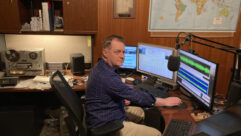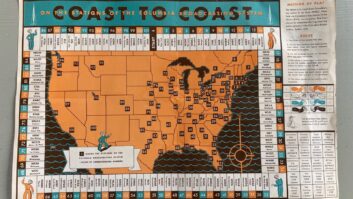Inspired by the Personal Video Recorder, Products Allow Time-Shifting of Programs
Since the VCR first made its way into the American living room in 1975, a few tinkerers have used videocassettes to record radio programs automatically. Though VCRs and timer-enabled audio recorders can be made to work, few offer an elegant and convenient way for listeners to time-shift radio programming.
Now, over a quarter century later, another video product, the TiVo personal video recorder, has spawned a variety of techniques for time-shifting radio programming to the listener’s personal preference.
This time the technology works well, thanks to a combination of easy-to-use software, cheap data storage media and computing hardware that fits in the palm of a hand.
However, early users of personal audio recording technology are still experimenting to determine its value in their lives, said Rob Enderle, chief executive at Enderle Research in San Jose, Calif., a firm specializing in personal technology.
“The segment is just emerging, and it’s not clear exactly what the market is going to be looking for,” Enderle said. “But I think it will take some time for the vendors to understand the user dynamics.”
Enderle said popular radio programs that air nationally at a fixed time each day are easily recorded with simple timer-based technology, while music programming, unlike its video counterpart, has yet to be listed in well-developed databases. He predicted it will be five years before the technology matures, and by that time most copyright issues that are now so contentious will have been resolved.
Have it your way
Electronics and software makers have so far approached the “Radio TiVo” concept in two main ways: as self — contained hardware — based receiver/recorders that emphasize portability in the hands of the listener, and as software applications that harness the power of a personal computer to become a high-fidelity home entertainment center.
(click thumbnail)PoGo! Products makes Radio YourWay, an AM/FM radio/Flash memory recorder.
PoGo! Products of Brea, Calif., puts the entire device in the listener’s hand. It’s Radio YourWay, a 2.8-ounce, $150 portable AM/FM radio/Flash memory recorder introduced last April. It lets the user record programming anytime, anywhere for later playback.
Recording can be as simple as pressing a button to record a particular broadcast; or its timer can be set up for unattended recording of one-time, daily or weekly programs.
The trade-off with the extremely compact Radio YourWay is audio quality. It records to 32 MB of internal Flash memory or to optional SD or MMC cards, sharing the same ADPCM codec used for voice recordings. This mid-range codec allows up to four hours recording on internal memory and is fine for talk and news programming. Critical listeners, however, will probably find it unsatisfying for music broadcasts.
Radio YourWay has many features beyond off-air recording, including MP3 and WMA playback, and quick file transfer via USB cable to a file manager application for Windows PCs. MP3 files also can be loaded to the device’s memory for field listening.
Beyond talk
A less integrated recording system comes from RPR Products of Tucson, Ariz. RPR takes a handful of separate components and packages them in a notebook folder configured as a time-shifting system for talk radio programming. The package, ranging in cost from $130 to $220, depending on features, contains an AM/FM radio, digital IC recorder and FM transmitter to play the recording through a car radio.
Any techie worth his salt could assemble an RPR-type package on his own, but the vendor emphasizes that it has carefully matched components and addressed common problems such as interference between digital recorders and AM receivers. To solve the interference issue, RPR said the radio and recorder are positioned apart in the carrying case.
More sophisticated, and emphasizing TiVo-like features, are new products appearing as software applications and peripherals for use with personal computers. These use the PC’s processing power and hard drive for high audio fidelity and more control tricks.
(click thumbnail)Griffin Technology offers RadioShark, a radio with time-shift and Internet recording capabilities for Apple Macintosh computers.
At a recent MacWorld computer show in New York City, Griffin Technology of Nashville launched its RadioShark, a $50 AM/FM radio with time-shift and Internet recording capabilities for Apple’s Macintosh computers. RadioShark, connecting via USB cable, can receive and record AM or FM radio broadcasts, allowing users to schedule the recording of radio events in advance. It also can record Internet audio streams, either scheduled or real-time, from any streaming audio application available.
However, RadioShark’s breakthrough feature allows the user to pause a live broadcast and then return to it in moments or even hours later, continuing where the listener left off. Just like TiVo.
“The fin-shaped device acts as the antenna and can be adjusted and positioned for best reception,” said Andrew Green, Griffin’s vice president of marketing. “Once connected, all radio tuning and control is through its full — featured front — end application.”
Recordings made through RadioShark can be transferred to an Apple iPod music player or any other AIFF-compatible digital music player for portable replay. The product is scheduled for delivery in late October, Griffin said.
Play it back
The lowest-cost and most advanced automated audio recording products are software applications for personal computers.
Ironically, the major free streaming audio players eschew timed recording; but there are a growing number of third-party products for the Windows and Macintosh platforms. The good news is that with a broadband Internet connection and high-quality codec, these applications can provide the most control and best fidelity of any solution.
On the Windows platform, Replay Radio ($29.95) from Applian Technologies of San Francisco mimics TiVo functionality for radio. Select a show, or station and time range, and the application records it for you.
It works with Internet radio broadcasts in any format, including Real, Windows Media and others. Once your show is recorded, the application creates MP3 files or a CD for listening anywhere. The entire process can be automated.
Replay Radio preprograms hundreds of shows and stations, making recording a point-and-click process. Applian also touts Replay Radio as a general-purpose recorder for archiving audio books, saving music, monitoring online police scanners and recording from devices attached to a PC (such as cassette decks or radio receivers).
More Info:Radio YourWay
Audio Hijack
For owners of Pocket PC devices, there’s a separate Replay Player ($19.95) application that allows programs recorded on by Replay Radio to work seamlessly on a portable device. Listeners easily can navigate radio programs recorded on their PC and quickly skip over blocks of commercials with the press of an on-screen button.
For users of Macintosh OS X, Audio Hijack Pro from Rogue Amoeba Software of Princeton, N.J., offers one of the most advanced personal audio recording applications available, at the modest price of $30. Yes, listeners can automatically record radio broadcasts and audio from any other application on the computer. But with Audio Hijack Pro, the sound can be sweetened with industry-standard VST and AudioUnit audio effects, as well as 15 custom DSPs included with the application.
Audio Hijack Pro is flexible and powerful. It can record any audio type, be it Real, Windows Media, or AAC to the AIFF or MP3 formats. Low-quality radio signals can be enhanced with DSP effects. Green Oak’s Excitifier VST plug-in, which is included, can be used to “un-muddy” music by adding the upper harmonics back.
With support for Apple’s built — in AudioUnit plug — in format, it comes with a parametric equalizer, a 31-band graphic equalizer, AUMatrixReverb and more. Audio levels can be monitored with the level meters, VU meters, menu bar Meters or mda’s Specmeters VST plug-in, included. With the Pipe Dream plug-in, serious computer geeks can pipe audio to any command-line application.
For timed recordings, there’s an entire package of timers. The application can function as an alarm clock, waking up the user to live radio, net streams, MP3s, DVDs, compact discs or any other audio desired.












